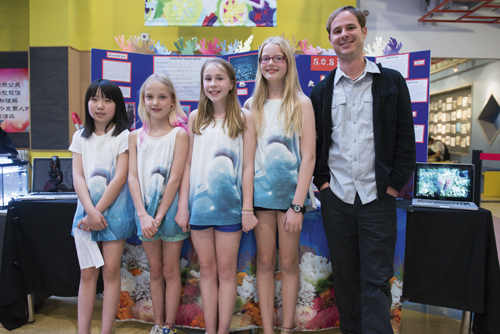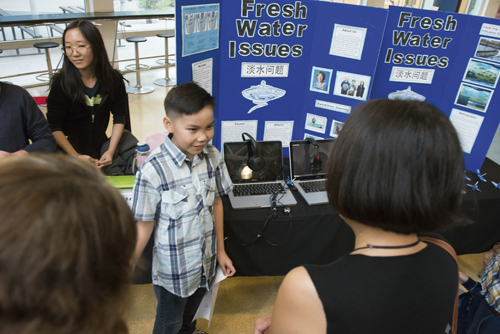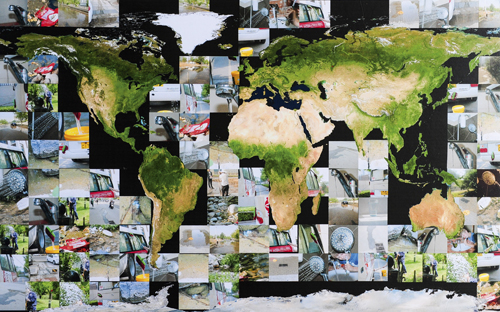For this month’s water-themed issue, we spoke to students committed to preserving aquatic ecologies and highlighting water conservation; from protecting coral reefs to dive clean ups and the world water crisis, these inspiring students are helping spread the message that the liquid resources on our planet are, indeed, finite. Each one of these students is an inspiration; taking time to investigate issues they’re passionate about, engage in in-depth inquiry and research, and take action in their school, their local community, and even the world.
Think Local, Act Global – Water Scarcity in 100 photos
Over at Beijing City International School (BCIS), Grade 5 student Jacob Richmond’s message to readers is simple – try to preserve the clean water we’ve got left.
For BCIS’ International Baccalaureate Primary Year’s Programme (IB PYP) Grade 5 Project, students must choose an artistic medium to illustrate their research. Jacob explains his photographic exhibition to beijingkids: “There are 100 photographs here and 99 of them are ways people waste water. For example, the very first photo is of a dripping tap. I’m trying show that the amount of water we’ve got is limited,” he says. “Ninety-nine percent of the world’s water isn’t drinkable, so there’s just one photograph illustrating that one percent which is.”

A UK native, Jacob has been living in Beijing four years. Jacob says he connected with this issue because of how much the issue of water scarcity will affect China. “In something like another 40 years, China won’t have enough clean water to drink,” he says.
So what causes the lack of water? Jacob says it’s an accumulation of small mistakes people often don’t realize contribute heavily to the problem, such as taking baths instead of showers or leaving the tap running while brushing our teeth. Jacob outlines actions to take in order to save the water we have left. “You can buy a dishwasher, if possible, and schools and businesses can install auto taps, which save 70 percent of water compared to manual taps. Try also to only use as much time as you really need in the shower; five minutes tops!”
Dive for Debris – SinoScuba Gives Back
To gain further perspective on water issues effecting Beijing, we speak to 15-year-old Tjeard van Oort, a Netherlands native who has lived in Beijing four years. The WAB student got his scuba diving certificate a year ago with SinoScuba, a Beijing-based instruction group that offers Professional Association of Diving Instructor (PADI) scuba diving courses. He recently participated in his first dive since his training; a cleanup project organized by SinoScuba which saw Tjeard and five others, including his dad, visit a fresh-water well, Mapao Quan, located about 30 minutes from Beijing.

“This spot is used as a scuba training area and it’s where I learned to dive,” Tjeard says. “But it’s also polluted, so we decided to clean it up to improve it. When there is severe pollution, the effect can be really problematic, visually and health wise. Tjeard describes the water at Mapao Quan as “clear until about 6 meters deep,” when the water becomes very cold and dark green, with low visibility.
The group spent about four hours at the site, collecting six trash bags full of debris. Though Tjeard felt tired from the long day of diving, he says he was pleased to have helped clean up the area and hopes to do more dives like this in the future. “It was very fun and I think that more people should contribute to these types of events. It’s good for you mentally and it helps improve the surrounding area.”

Tjeard contends that it’s important for teens and younger kids to contribute to clean up projects like this one as they can teach future generations the necessity of caring for the environment. That being said, Tjeard feels that a real difference can only be made through educating kids on the problems caused by water debris. “Events like these help clean up dive areas and promote the idea of keeping the world clean but, the issue of water debris should [continually]be taught in school,” he says.
SOS Reef – Project Aware
“Have you ever seen a bleached coral?” asks the all-girl, coral reef conservation group.
At WAB for the school’s IB PYP Exhibition, four Grade 5 students present their project to a circle of parents, siblings, and teachers who have gathered to show support and ask questions about their findings.

“We are taking action and researching coral reef destruction because coral reefs are disappearing at an alarming rate due to human activity and this is unacceptable,” the students’ giant poster board reads.
For those who don’t know, coral reefs are essential building block of the under water world and form some of the largest, most diverse ecosystems on earth. Furthermore, coral reefs are a structure to support marine life and provide a home for an estimated 25 percent of all marine life species according to US-based National Oceanic and Atmospheric Administration (NOAA). Group member Ava Targett lets us in on some of the alarming factors contributing to the disappearance of coral reefs, with global warming at the top of the list.
“It is certain that global warming is the main cause of coral bleaching, which is when the temperature of the water rises and gets too hot for the coral to survive,” she says.
In addition, industrial waste, oil spills, as well as careless tourism and fishing practices such as blast (or dynamite) fishing all account for local threats to coral reefs populations.

The students bring me to a small, glass tank full of colorless corals – an example of what coral reefs will look like in the future if C02 emissions continue on the current trajectory. “We’re trying to represent that if water temperatures rise by four degrees Celsius due to CO2 emissions, eventually all the coral will bleach and die,” says Ava.
“Even if temperatures rise by one degree, it will have a major impact on coral reefs,” adds group member Lauren Ambraz.
The girls say that if we don’t act fast, the next generation might not be able to witness the beauty of coral reefs at all. “My dad and I are both divers and we really love seeing the coral reefs, so I really want to try hard to save them,” Lauren says

The group says there are many ways to take action however, one of the most important ways is to educate others who may not know very much about coral reefs or why they’re important to the world’s ecosystem. Below, are helpful tips from the WAB students and NOAA on taking action to save our planet’s coral reefs:
How you can take action
- Be a mindful tourist: When snorkeling or scuba diving, be spatially aware and careful not to kick and break the coral into pieces.
- Take a picture, not a coral: Many tourists cut, kill, and steal coral as a souvenir. If you see this happening, suggest they take a picture instead.
- Conserve electricity and reduce CO2 emissions: By turning off the lights or other devices when idle, you are helping reduce CO2 emissions.
- Recycle and dispose of trash responsibly.
- Organize a beach clean-up: If your family goes to the beach on holiday, why not organize a few hours dedicated to cleaning the coastline?
- Share what you learn with others: Inform yourself and others by finding out about existing laws, programs, and projects that could conserve the world’s coral reefs.
- Don’t buy coral products: Don’t support the coral souvenir industry.
Before wrapping up, the girls ask to share a message with beijingkids readers: “Take action and try hard to save the coral reefs. Remember, if you save a coral reef, you save our planet.”
Resources
Beijing City International School
Shuangjing / Dongsihuan, 77 Baiziwan Nan Er Lu, Chaoyang District (8771 7171, admissions@bcis.cn) www.bcis.cn 双井东四, 朝阳区百子湾南二路77号
SinoScuba
Founded in 2003 by PADI IDC Staff Instructor Steven Schwankert, SinoScuba offers PADI scuba diving courses from Discover Scuba Diving up to Assistant Instructor. Disclosure: Steven Schwankert is the managing editor of beijingkids’ sister publication, the beijinger. Sanlitun,
Workers’ Stadium South Gate, Chaoyang District (186 1113 3629
steven@sinoscuba.com) www.sinoscuba.com三里屯, 朝阳区工人体育场南门
The Western Academy of Beijing
Laiguangying and Beigao, 10 Laiguangying Donglu, Chaoyang District (5986 5588, wabinfo@wab.edu) www.wab.edu来广营和北皋,朝阳区来广营东路10号
This article originally appeared on page 38-41 of the beijingkids July 2015 issue. Click here to read the issue for free on Issuu.com. To find out how you can get your own copy, email distribution@truerun.com.
PHOTOS: COURTESY OF WAB, BCIS, AND JETHRO CRAMP




